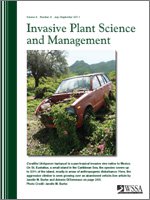Wild chervil is an invasive biennial or short-lived perennial weed introduced into North America that negatively impacts forage production and degrades habitat for native plant species. A 2-yr study using prebloom mowing followed by combinations of herbicide, tillage, and grass seeding was conducted in the Pacific Northwest to identify an effective integrated weed management strategy for this species. By 2 mo after herbicide treatment (MAHT), wild chervil control with glyphosate ammonium sulfate (AMS) and clopyralid was 83 and 73%, respectively. Tillage with or without herbicide pretreatment resulted in 92 to 98% wild chervil control at 2 MAHT, whereas herbicide without tillage gave only 45% control across all treatments. Tillage with or without subsequent grass seeding reduced wild chervil density four-fold compared to herbicide alone at 9 MAHT. Herbicide tillage grass seeding resulted in similar wild chervil cover (1 to 5% cover) as herbicide tillage (1 to 6% cover) without subsequent grass seeding. Wild chervil biomass at 1 yr after herbicide treatment (YAHT) was reduced to 487 kg ha−1 (439 lb ac−1) with herbicide tillage compared to 4,256 kg ha−1 for herbicide treatment alone. Herbicide tillage grass seeding increased grass dry weight at 1 YAHT from 201 kg ha−1 for herbicide tillage to 1,575 kg ha−1, compared to 351 kg ha−1 in herbicide-only plots.
Nomenclature: Clopyralid; dicamba; glyphosate; triclopyr; 2,4-D; wild chervil; Anthriscus sylvestris (L.) Hoffmann.
Interpretive Summary: Wild chervil is an introduced biennial or short-lived perennial species found in the northeastern and midwestern states and adjacent Canada, as well as in middle Atlantic states and the Pacific Northwest. Control of this invasive plant is desirable, given its ability to reduce forage yield and quality, and to degrade native habitat. Mowing wild chervil prior to treatment with herbicides moderately increases control, but the impact of tillage on wild chervil control previously has not been examined. Because chemical or mechanical control of weeds in pastures and natural areas often results with injury to or elimination of nontarget plant species, revegetation of the site using well-adapted or native species generally must follow weed-control efforts. With these facts in mind, an integrated weed management strategy for wild chervil was developed that utilized prebloom mowing, herbicide application, and tillage, followed by seeding of well-adapted perennial grass species. An experiment was designed to test the effectiveness of this strategy, and two trials were conducted in the state of Washington from 2003 to 2005.
Tillage as used here provided 92 to 98% control of wild chervil at 2 mo after treatment, with or without a pretillage herbicide application. At 1 yr after treatment, wild chervil biomass was reduced nine-fold if plots were tilled after herbicide application, but seeding grass into tilled plots was necessary to increase grass biomass. In areas where tillage such as used here is not possible, glyphosate application should provide satisfactory control of wild chervil. Because wild chervil seed does not persist long in the field (often surviving only one winter), lasting control of this invasive weed species likely will result from a consistently-applied integrated control strategy such as presented here.





